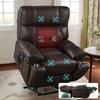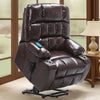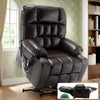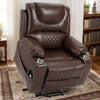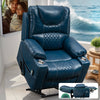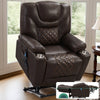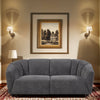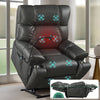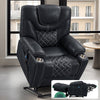The Rise of Sectional Sofas in Modern Home Loungewear
The Evolution of Sectional Sofas and Consumer Preferences
Sectional sofas have come a long way since their inception. They've evolved to meet changing consumer needs. In the past, these sofas were bulky and less stylish. Now, they offer sleek designs and multiple functions.

Today's consumers value versatility and comfort. Sectional sofas deliver both. They can be rearranged to fit different spaces. This flexibility is a big selling point. Many people also appreciate their modular nature.
The popularity of open-plan living has boosted sectional sofa sales. They can define spaces within larger rooms. This makes them ideal for modern homes. As families spend more time at home, the demand for comfy, adaptable seating has grown.
Advantages of Sectional Sofas for Elderly Longevity and Mobility
Sectional sofas offer several benefits for older adults. Their design can support aging in place. Here are some key advantages:
- Easy to get in and out of due to their low height
- Provide ample seating for family gatherings
- Can include reclining sections for added comfort
- Often feature built-in storage for convenience
- Allow for customized arrangements to suit mobility needs
These sofas can be a great alternative to lift recliner chairs for the elderly. They offer similar comfort without looking medical. This helps maintain a homey feel while still meeting needs.
Many sectional sofas now come with power recline features. These are perfect for those with limited mobility. They allow users to find their ideal position with ease.
Impact of Design and Material on Elderly Comfort
The design and materials used in sectional sofas greatly affect comfort for older adults. Soft, yet supportive cushions are crucial. They should provide enough give without being too plush.
Fabric choice is also important. Easy-to-clean materials are best for spills and accidents. Leather or faux leather can be good options. They're durable and simple to wipe down.
The frame of the sofa matters too. A sturdy frame provides the support needed for safe sitting and standing. Some designs include built-in handles or grab bars. These can help with balance and mobility.
Colors and patterns can impact comfort as well. Softer, calming hues may be preferable. They can create a relaxing atmosphere. This is especially important for those with sensory sensitivities.
Evaluating the Ergonomics of Traditional Seating for the Elderly
The Science of Comfort: Orthopedic Features of Traditional Chairs
Traditional chairs can be designed with orthopedic features to support elderly users. These features focus on proper alignment and pressure distribution. Good lumbar support is key. It helps maintain the natural curve of the spine.

Seat height is another crucial factor. It should allow feet to rest flat on the floor. This reduces strain on the legs and back. Armrests at the right height can aid in sitting down and standing up.
Some traditional chairs come with memory foam cushions. These mold to the body's shape for personalized support. High-density foam can prevent sagging over time. This ensures long-lasting comfort for daily use.
Ergonomic chairs often have a slight forward tilt. This encourages better posture and easier standing. It's a subtle feature that can make a big difference for older adults.
Balancing Style and Support in Traditional Furniture
Finding the right balance between style and support is crucial in traditional furniture. Many older adults prefer classic designs. They want furniture that fits their home's aesthetic. But they also need proper support for comfort and safety.
Manufacturers are responding to this need. They're creating stylish chairs with hidden supportive features. For example, wingback chairs with extra lumbar cushions. Or elegant rockers with smooth, easy-to-use mechanisms.
Color and fabric choices play a role in balancing style and function. Stain-resistant fabrics in classic patterns offer practicality and beauty. Neutral colors can blend with various decor styles while hiding wear and tear.
Some traditional furniture now includes subtle mobility aids. These might be higher seat bases or firmer cushions. They provide support without compromising on classic looks.
Customization Options for Maximized Comfort
Customization is key in traditional seating for the elderly. Many furniture makers offer options to tailor chairs to individual needs. This ensures maximum comfort and usability.
Some common customization options include:
- Adjustable back angles for personalized support
- Interchangeable cushions with varying firmness levels
- Removable arm covers for easy cleaning
- Add-on headrests for extra neck support
- Swivel bases for easier access
These options allow for a perfect fit. They can address specific health concerns or preferences. For example, someone with arthritis might choose softer arm pads. Another person might opt for a higher seat to ease standing.
Some companies offer in-home consultations. An expert can assess the user's needs in their own environment. This leads to truly personalized seating solutions.
Integrating Sectional Sofas into Various Home Settings
Optimizing Small Spaces for Versatile Uses with Sectional Sofas
Sectional sofas are great for maximizing small living areas. Their modular design allows for creative arrangements. This flexibility is perfect for compact homes or apartments.

In small spaces, a sectional can serve multiple purposes. It can be a couch during the day and a guest bed at night. Some models include storage compartments. These are ideal for hiding blankets or other items in tight quarters.
L-shaped sectionals can help define separate areas in studio apartments. They create a natural divide between living and sleeping spaces. This is especially useful for elderly individuals in smaller homes.
Corner sectionals make use of often-wasted space. They fit snugly into room corners, leaving more floor area open. This can make a room feel larger and more accessible for those with mobility aids.
Sectional Sofas in Multi-Generational Households: Blending Functionality and Flexibility
Multi-generational homes benefit greatly from sectional sofas. They provide ample seating for family gatherings. Their versatility accommodates different age groups and needs.
For older adults, some sections can be equipped with lift mechanisms. This mimics the function of lift recliner chairs for the elderly. Other parts can be lower for children or standard height for adults.
Modular designs allow for easy rearrangement. This is helpful when needs change over time. As family members age or move, the sofa can adapt to new situations.
Some sectionals include removable covers. This feature is great for homes with both young children and older adults. Spills and accidents can be easily cleaned up, maintaining a hygienic environment for all.
Future Trends: Innovations in Longevity Furniture Design
The future of furniture design is focusing on longevity and adaptability. Smart features are being integrated into sectional sofas. These can include:
- Built-in sensors to monitor sitting posture
- Automated adjustments for optimal comfort
- Voice-controlled reclining functions
- Heating and massage capabilities
Materials are evolving too. New fabrics resist wear and tear better than ever. This means furniture lasts longer, even with heavy use by multiple generations.
Modular designs are becoming more sophisticated. Future sectionals might allow for easy addition or removal of seats. This could help furniture grow or shrink with changing family sizes.
Sustainability is another key trend. Manufacturers are using more eco-friendly materials. They're also designing for easy repair and part replacement. This extends the life of furniture and reduces waste.








